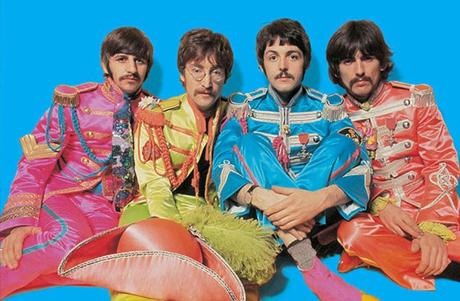 The Beatles in uniform on Sgt. Pepper’s Lonely Hearts Club Band (1967)
The Beatles in uniform on Sgt. Pepper’s Lonely Hearts Club Band (1967)The Flip Side
When I finished writing and posting Part One of this piece, I realized to my dismay that I might have misled readers into thinking the Beatles’ revolutionary Sgt. Pepper’s Lonely Hearts Club Band album was anything but one of their best.
Au contraire, mes frères! I was simply addressing the conventional wisdom that the record was the be-all and end-all of pop music in the mid- to late 1960s. There’s no refuting the fundamental effect Sgt. Pepper has had on the popular culture of its day.
From the reduced time intervals that separate each number from one another; from the innovative manner in which the songs were recorded, to the printing of the lyrics on the gatefold sleeve’s backside; and, most curious of all, the cardboard cutouts and cover art figures ranging from Bob Dylan, Marlon Brando, Marilyn Monroe, Lenny Bruce, W.C. Fields, Johnny Weissmuller, Aldous Huxley, H.G. Wells, Tony Curtis, Laurel and Hardy, Fred Astaire, Oscar Wilde, Edgar Allan Poe, and Karl Marx, as well as wax models of Sonny Liston, Diana Dors (the British version of Marilyn), and the mop-topped Beatles themselves, this was Andy Warhol territory writ large and in bold musical lettering — more proof that the album was a noteworthy by-product of 1967.
However, one of the downsides of its release sealed the group’s eventual doom, i.e. the impossibility of reproducing Sgt. Pepper’s contents in concert and on tour, making it a virtual one-off. This became true of the bulk of the Beatles’ output at this stage in their development — one of several reasons the band stopped touring at the end of August 1966.
Today, of course, that argument would never hold up. The irony of using that strategy as a pretext for their breakup (or one of the explanations proffered for same) is apocryphal at best. If the Beatles had only waited a few more years — say, around the time Pink Floyd ventured onto the scene with Dark Side of the Moon — they could have easily replicated their album in its entirety without noticeable loss of authenticity.
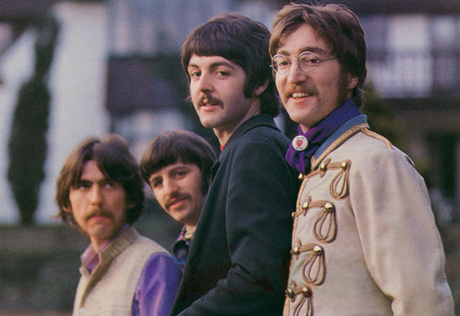
Hogwash and balderdash! Wishful thinking you might say? Hmm, perhaps! But as we know from pop music history, there were forces beyond their control (and already at play) in the year 1967 that would continue to drive the Beatles apart as a working unit. For the sake of this post, let it be said that Sgt. Pepper remains a masterpiece of pop-music confection, one that expanded their artistic horizons to unheard-of heights.
The “theme” or motif for the album was set from the start by the front-cover photo of the Beatles in brightly-colored, marching-band uniforms complete with string decorations, shoulder epaulettes, three-corner hat, and instruments of varying degree (to be exact, a French horn, a trumpet, a cor anglais and a flute). The words “A splendid time is guaranteed for all” are splashed across the backside of the album, about as reliable a guarantee of quality as any in the field of pop.
The first number on the record is the title tune, “Sgt. Pepper’s Lonely Hearts Club Band.” It begins with an orchestra tuning up for a concert in the midst of an expectant audience. As our boys enter one by one, we hear several audience members break into laughter (possibly, at the sight of Ringo stumbling clumsily onto the stage). The setup was a positively striking one: moving away from their earlier clean-cut image, the Beatles announced to the pop-music world that they had transformed from the drab, cutesy-pie teen idols of the early 60s into the hip, alternative Mod-style artists of the “Summer of Love.” In spite of the portentous opening lines, the Beatles have never gone “in and out of style”:
It was twenty years ago today
Sgt. Pepper taught the band to play
They’ve been going in and out of style
But they’re guaranteed to raise a smile
So may I introduce to you
The act you’ve known for all these years
Sgt. Pepper’s Lonely Heart Club Band
We’re Sgt. Pepper’s Lonely Hearts Club Band
We hope you will enjoy the show
We’re Sgt. Pepper’s Lonely Hearts Club Band
Sit back and let the evening go
The tune, in slightly truncated form, is reprised on side two (of the LP that is) as the penultimate cut, which gave a false close to the “concert” program that came before. “Paul [McCartney] explained that [the concept] was like a band you might see in the park,” remembered Peter Blake, the man responsible for staging the album cover. “[T]hey were a town band finishing a concert in a park, playing on a bandstand with a municipal flowerbed next to it, with a crowd of people around them” — the kind who “stood and stared,” I would bet.
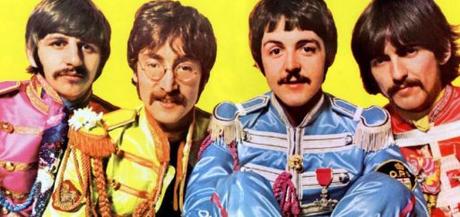
Paul confirmed the idea. “I thought it would be nice to lose our identities, to submerge ourselves in the persona of a fake group. We would make up all the culture around it and collect all our heroes in one place. So I thought, a typical stupid-sounding name for a Dr. Hook’s Medicine Show and Traveling Circus kind of thing [no relation to Monty Python’s Flying Circus] would be Sgt. Pepper’s Lonely Hearts Club Band. Just a word game, really.”
There were more “word games” to come. But the “concert” and “fake group” aspects, as Paul liked to refer to them, didn’t exactly bear out for the entire length of the album. John Lennon was opposed to the concert idea from the start (it “left him cold,” according to sources). Nevertheless, he went along with the notion, as did the production crew.
The title track segues directly into Ringo’s signature tune (in his guise as “Billy Shears”), “With a Little Help from My Friends,” with its reference to Marc Antony’s speech from Julius Caesar, the snappy call-and-response banter of the main chorus, and hints of marijuana use (denied by John, by the way):
What would you do if I sang out of tune
Would you stand up and walk out on me?
Lend me your ears and I’ll sing you a song
And I’ll try not to sing out of key
Oh, I get by with a little help from my friends
Mm, I get high with a little help from my friends
Mm, gonna try with a little help from my friends
Do you need anybody?
I need somebody to love
Could it be anybody?
I want somebody to love
Next, we are treated to a faux harpsichord intro to “Lucy in the Sky with Diamonds” (done on the Hammond organ and suggestive of Beethoven’s solo piano piece, “Für Elise”), a Lennon song just as often mistaken for endorsing LSD use as Ringo’s “get high” phrase above (well, not entirely mistaken: John was dropping considerable amounts of “acid” at this point). The title is based on a picture that Lennon’s son Julian painted at school of a classmate named Lucy. Comprised of a hodgepodge of surrealistic nonsense words, the lyrics mixed psychedelia with a Lewis Carroll aesthetic.
“The images were from Alice in Wonderland,” John told Playboy in 1980. “It was Alice in the boat. She is buying an egg and it turns into Humpty Dumpty. The woman serving in the shop turns into a sheep and the next minute they are rowing in a rowboat somewhere, and I was visualizing that. There was also the image of the female who would someday come to save me — a ‘girl with kaleidoscope eyes’ — who would come out of the sky.”
Picture yourself in a boat on a river
With tangerine trees and marmalade skies
Somebody calls you, you answer quite slowly
A girl with kaleidoscope eyes
Cellophane flowers of yellow and green
Towering over your head
Look for the girl with the sun in her eyes
And she’s gone
Lucy in the sky with diamonds
Lucy in the sky with diamonds
Lucy in the sky with diamonds
Ah, ah
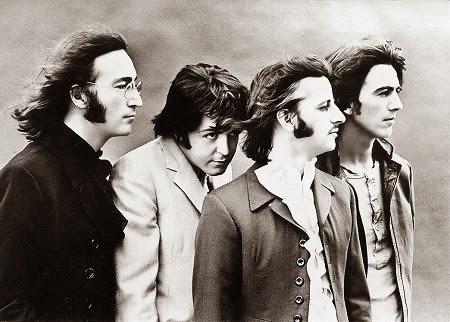
The following two entries, “Getting Better” and “Fixing a Hole,” are basically throwaways — that is, if you skip over the lyrics and go on to the succeeding number, “She’s Leaving Home.” But if you did that, you would be doing yourself a disservice. Simply put, these two back-to-back numbers are nothing if not an instructive look into the mind-set of their authors, Lennon and McCartney.
John and Paul worked together on these songs, but Paul is credited chiefly for both. “Fixing a Hole” came a month before “Getting Better” (though placed in reverse order on the album) and written after McCartney had repaired a physical hole in his Scottish farmhouse roof. Stated Paul, “This song is just about the hole in the road where the rain gets in; a good old analogy — the hole in your makeup which lets the rain in and stops your mind from going where it will. It’s you interfering with things.”
And it really doesn’t matter if I’m wrong I’m right
Where I belong I’m right
Where I belong
See the people standing there who disagree and never win
And wonder why they don’t get in my door
I’m painting my room in a colorful way
And when my mind is wandering
There I will go …
Silly people run around they worry me
And never ask why they don’t get past my door
I’m taking the time for a number of things
That weren’t important yesterday
And I still go
I’m fixing a hole where the rain gets in
And stops my mind from wandering
Where it will go
On “Getting Better,” George Harrison played the tampura, an Indian instrument that resembles an extra-large sitar. It produces a sort of droning noise and is mostly used for background resonance. The song itself was composed at Paul’s home in St. John’s Wood. Lennon was present and contributed “that lovely little sardonic line” about “It couldn’t get much worse.” Paul was decidedly more optimistic about the world in general, etched with a streak of regret; whereas John had anger management issues, as he confessed in those revealing (pun intended) Playboy interviews:
“I used to be cruel to my woman, and physically — any woman. I was a hitter. I couldn’t express myself,” John added, “and I hit.”
It’s getting better all the time
I used to get mad at my school
(No, I can’t complain)
The teachers who taught me weren’t cool
(No, I can’t complain)
You’re holding me down
Turning me round
Filling me up with your rules
I’ve got to admit it’s getting better (Better)
It’s getting better all the time
(It can’t get much worse)
It’s getting better all the time
It’s getting better
Since you’ve been mine
The following verses were Paul and John’s shared thoughts, each expressing his particular fascination with or disappointment in their interpersonal relationships. Try to guess which one was which:
Me used to be an angry young man
Me hiding me head in the sand
You gave me the word, I finally heard
I’m doing the best that I can
I used to be cruel to my woman
I beat her and kept her apart from the things that she loved
Man, I was mean but I’m changing my scene
And I’m doing the best that I can (ooh)
And now, an honest to goodness minor classic, the sorrowful ballad “She’s Leaving Home.” Its close affiliation with “Eleanor Rigby,” featured on the group’s Revolver, can be attributed to the presence of strings (arranged by Mike Leander instead of George Martin), with the harp providing added import to “She’s Leaving Home.”
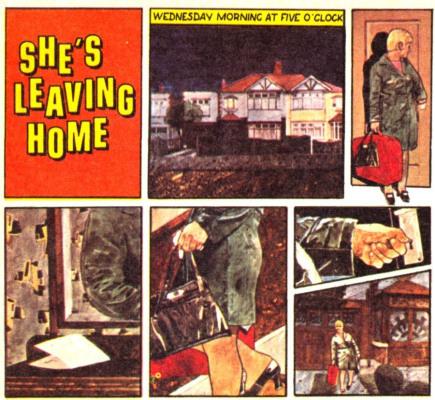
A true Lennon-McCartney original (neither Beatle played any instruments on the track, nor were Ringo and George present during the recording sessions), the oft-told chronicle of how this song came about is worth repeating:
“It’s a much younger girl than Eleanor Rigby,” Paul remarked in Beatles in Their Own Words, “but the same sort of loneliness. That was a Daily Mirror story again [identified as the Daily Mail in The Long and Winding Road: A History of the Beatles on Record]…. We’d seen a story in the newspaper about a young girl who had left home and not been found. There were a lot of those at the time. That was enough to give us a story line. So I started to get the lyrics: she slips out and leaves a note and then the parents wake up and then … It was rather poignant. I like it as a song, and when I showed it to John, he added the Greek chorus, long sustained notes, and one of those nice things about the structure of the song is that it stays on those chords endlessly.”
Paul mentioned that one of the lines in the song may have come directly from the girl’s father, quoted in the newspaper article: “I cannot imagine why she should run away. She has everything here … even her fur coat.”
“But he didn’t give her that much,” McCartney insisted, “not what she wanted when she left home.”
The girl, identified as teenager Melanie Coe, disappeared from her family’s abode in February 1967. Melanie took only what she was wearing, leaving behind her “Austin 1100 automobile, two diamond rings, a mink coat,” and “a wardrobe full of clothes.”

John was purported to have agreed with the song’s basic premise, adding: “Paul had the basic theme … but all those lines like ‘We sacrificed most of our life’ [and] ‘we gave her everything money could buy,’ those were things [my aunt] Mimi used to say to me. It was easy to write.” John was credited with the chorus, but the individual lines were Paul’s work:
Wednesday morning at five o’clock as the day begins
Silently closing her bedroom door
Leaving the note that she hoped would say more
She goes down the stairs to the kitchen clutching her handkerchief
Quietly turning the backdoor key
Stepping outside she is free
She (We gave her most of our lives)
Is leaving (Sacrificed most of our lives)
Home (We gave her everything money could buy)
She’s leaving home after living alone
For so many years
This song, while a melancholy break from the liveliness of the previous tracks, prepares the listener for more serious excursions toward the album’s end. There were lots going on in Great Britain at the time than just granny glasses, Twiggy and Carnaby Street.
For the last item on this side, the Fab Four (or the one, in this instance) turned to the English dance hall, the equivalent of our turn-of-the-century vaudeville, for the bouncy “Being for the Benefit of Mr. Kite.” A one-hundred-percent John Lennon composition, this number, along with the preceding “Lucy in the Sky with Diamonds,” led producer George Martin to label him as “an oral Salvador Dalí.”
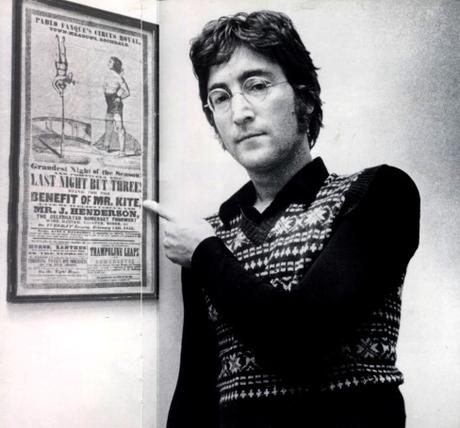
The unusual non-rock arrangement included four harmonicas (played by George, Ringo, and session players Mal Evans and Neil Aspinall), Hammond and Wurlitzer organs, a single piano, recorded snippets of an old Victorian steam organ, and bass and lead guitars (essayed by multi-instrumentalist Paul). John was the lone vocalist. Inspiration for this number was taken from a poster, of all things:
“ ‘Mr. Kite’ was a straight lift,” Lennon observed in The Beatles. “I had all the words staring me in the face one day when I was looking for a song. It was from this old poster I’d bought at an antique shop. We’d been down in Surrey or somewhere filming a piece … There was a break, and I went into this shop and bought an old poster advertising a variety show which starred Mr. Kite. It said the Hendersons would also be there, late of Pablo Fanques Fair. There would be hoops and horses and someone going through a hogshead of real fire. Then there was Henry the Horse. The band would start at ten to six. All at Bishopsgate. Look, there’s the bill, with Mr. Kite topping it. I hardly made up a word, just connecting the lists together. Word for word, really.”
Really! Nothing further need be added.
(End of Part Two)
To be continued….
Copyright © 2017 by Josmar F. Lopes
Advertisements
